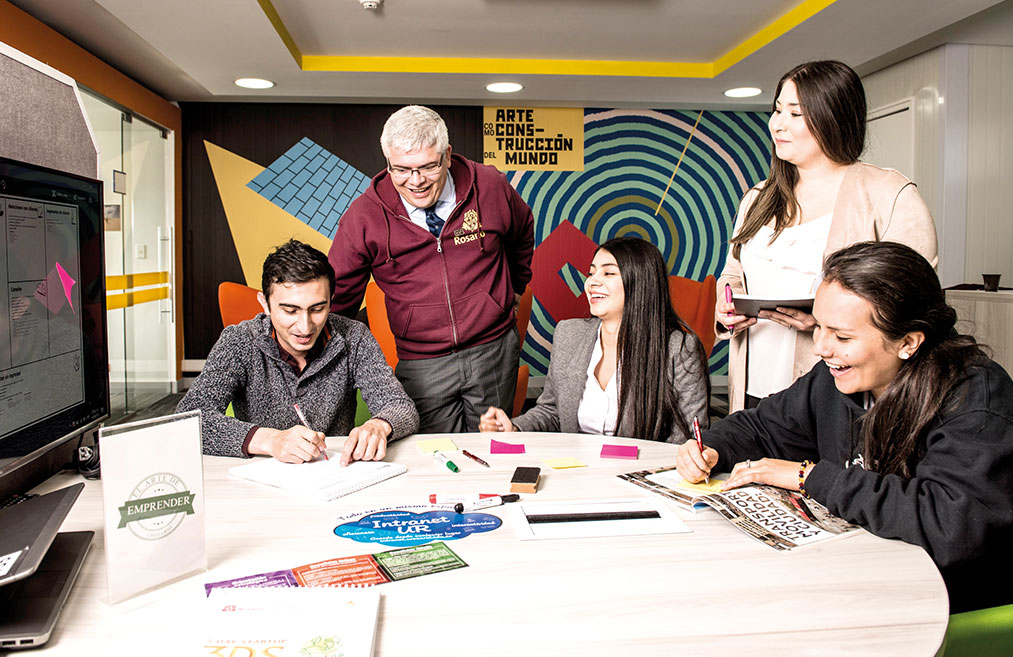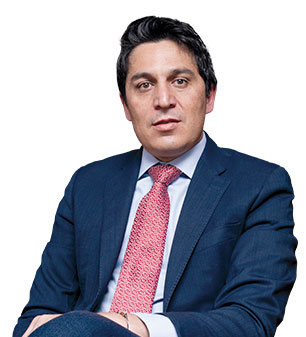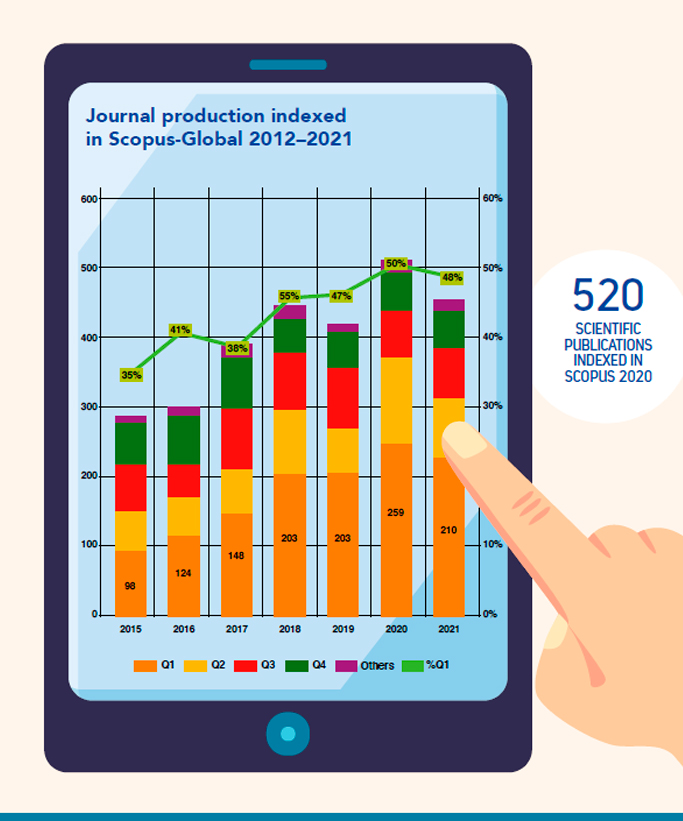A strengthened ecosystem to research and innovate
By: Ninfa Esperanza Sandoval Rojas
Photos:
Science and Tech

By: Ninfa Esperanza Sandoval Rojas
Photos:
In 2000, on the eve of the third millennium, the Universidad del Rosario set a specific research goal: to build and consolidate a scientific ecosystem that includes the entire Rosario community to develop research and innovation with results applicable to the national, regional, and global issues.
To achieve that purpose, the Research and Innovation Office, which is currently directed by Juan Miguel Gallego Acevedo, a professor at the School of Economics, has developed a process with a projection until 2025. This comprises three stages: coverage, developing research capabilities, and cuttingedge science
During the coverage stage, between 2000 and 2013, the research career was recognized and the first publication incentives were generated through the Research Fund of the Universidad del Rosario (Fiur). “The professors made the scientific process a part of their lives and had time to research, create, and innovate within their work plans,” recalls the Director Gallego.
Between 2014 and 2017, progress was made in building capacities for research and innovation management. During that period, the Research and Innovation Office was established and the Research Promotion Fund was created, thus consolidating the first financial and management instruments to train, promote, and encourage small-, medium-, and large-scale projects. “The institutionalization and management of this stage yielded important results in the constantly growing number of indexed publications in all disciplines,” he explains.
The current management is developing the Ruta 2025-UR Research & Innovation, i.e., the third stage, where the three pillars are being worked on the following:
The first one is “cutting-edge science,” which is how researchers contribute to their disciplines from a novel, creative, and excellence approach.
The second one is “establishing knowledge networks” or “invisible schools for science,” as Gallego calls them. These are expected to leverage large resources to solve the problems of the country, region, and world.
Finally, the third one is “formative research and training for research,” which seeks to identify talents among students at all levels to impact their training and build a legacy for the country’s scientific development in new generations
Gallego emphasizes that in the first pillar, “cutting-edge science,” URosario has gained significant progress. Although the scientific production differs among disciplines, the growth of publications, in quantity and quality, has been constant for a decade.
In 2020, 7 out of 10 of the total 489 articles were indexed in Q1 and Q2 categories, according to Scopus. More importantly, 70 percent of the publications in Q1 are located in the top 10 percent for the highest quality and impact journals, within the largest peer-reviewed database of scientific articles, abstracts, and references in the fields of science and technology, more specifically in medicine, social sciences, arts, and humanities.
The production of books, chapters, and new dissemination formats also indicates a growing evolution during the last five years through a publishing house that publishes under the highest quality standards.
Similarly, the achievements of schools and faculties show progress in “cutting-edge science.” The School of Medicine and Health Sciences, for instance, is a pioneer in research with A1 and A category groups that solve substantial problems for the country and whose publications represent 53 percent of the total number of those indexed by the university in 2020. In this sense, it is the most mature school in the ecosystem
The Faculty of Natural Sciences, more-over, has grown significantly during the last five years; 85 percent of its scientific production is Q1.
Faculty of Economics has a similar standard, with a production of 75 percent in Q1. In both cases, the scientific production is also in the top 10 percent of the best journals in their disciplines. The School of Engineering, Science, and Technology has just started its production in 2020, with a significant demand for new projects.
As for the School of Business Administration, School of Human Sciences, and the Faculty of Law and Faculty of International, Political, and Urban Studies, they are progressing with diverse and new formats, such as chapters and books, as well as in scientific production increasingly indexed in growing percentages in production in Q1 and Q2.

The quality indicators reflected in the number and quality of publications show a highly productive ecosystem, with high-quality peaks that respond to the instruments and institutional adjustments of the firm commitment of URosario during the last 20 years,” emphasizes the director.
Regarding the consolidation of the capacities of research groups and leadership in forming alliances at the national and international levels, the second pillar, Gallego explains that they seek to attract financing to develop innovative projects for solving major problems: “Grouping and taking advantage of capacities has allowed us to attract resources from the European Community (EC), Inter-American Development Bank (IDB), World Bank, Development Bank for Latin America, and International Development Research Center (IDRC), among other major funders.”
Inter-institutional alliances with national universities with the level of research maturity similar to that of URosario have allowed the treatment of problems in different fields. For example, around the Sustainable Development Goals (SDGs), with the Universidad de los Andes and Pontificia Universidad Javeriana; COVID-19, with the Universidad Nacional; and regarding the clinical field, with the Fundación Cardioinfantil.
In the case of projects, Gallego mentions the Formal and Inclusive Economy Alliance (EFI), one of the eight ecosystems of the Colombia Científica program, which has a national government funding of 18 billion pesos over five years and an institutional compensation of approximately 13 billion pesos. “We also ventured into royalties with the Casanare Transmedia LAB project, where we worked with the Casanare Chamber of Commerce, Casanare en Red, the Center for Technological Development for Sustainability and Regional Competitiveness C-Star, and the Colombian Association of Journalism and Science Communication (ACPC),” he explains. “As you can see, the system is vital and active,” Director Gallego specifies. “Today we are considered one of the five largest ecosystems in the country, thanks to the quality of our research, and this allows us to make new alliances in the other regions of Colombia to solve the real problems of local communities. Moreover, hand in hand with institutional partners that work in the same format, we will be able to help create new scientific ecosystems in Latin America.

Juan Miguel Gallego Acevedo, the director of research and innovation and a professor at the School of Economics, explains that Universidad del Rosario is considered among the five largest research ecosystems in the country and that this allows it to make new alliances in the other regions of Colombia to solve the real problems of local communities.
Between 2015 and 2020, Universidad del Rosario invested 23 billion pesos directly in the formats that promote the scientific ecosystem and that involve the entire Rosario community, from sixth-semester undergraduate students (identified as potential researchers), through professors, researchers, and PhD graduates, who are beginning to create their own networks and ecosystems.
In 2021, during one of the most critical moments due to the pandemic and economic crisis, the university reinforced projects and research funding in all its disciplines with a leverage of 6.5 billion pesos of internal funds. These were intended for research calls, publication support, teaching staff training, and publication incentives.
The organizational and economic efforts are accompanied by a constant search for external resources within and outside the country comparable to the institution’s own investment. “We invest one peso and get another one. This way, it is possible to guarantee the permanent continuity and evolution of highquality research, innovation, and knowledge transfer of a high social, technological, or commercial impact for the country and region,” explains Gallego.
The Director of the Research and Innovation Department feels that the scientific ecosystem of URosario today has the structure and infrastructure necessary to execute strategies, resources, and partnerships that bring the university closer to the goals outlined in the Ruta 2025 (Route 2025).
Although the scientific production differs among disciplines, the growth of publications, both in quantity and quality, has been constant over the last decade.



